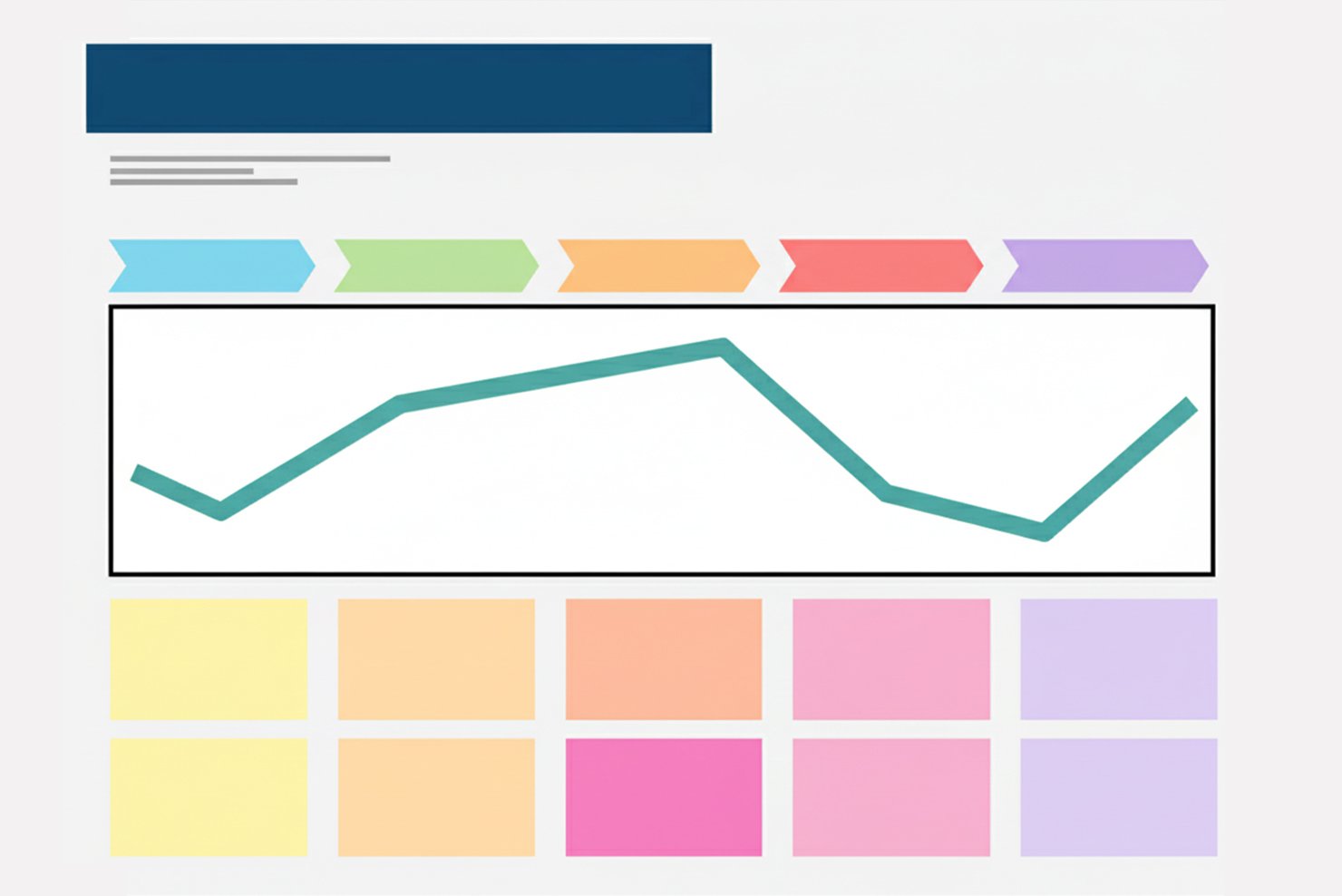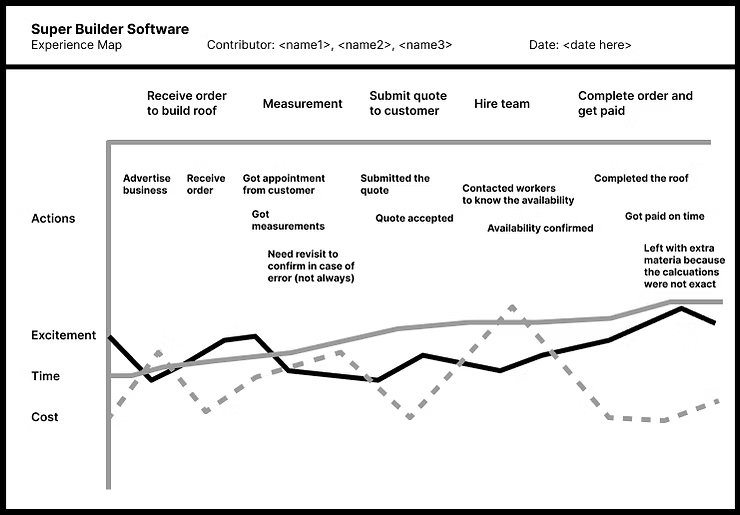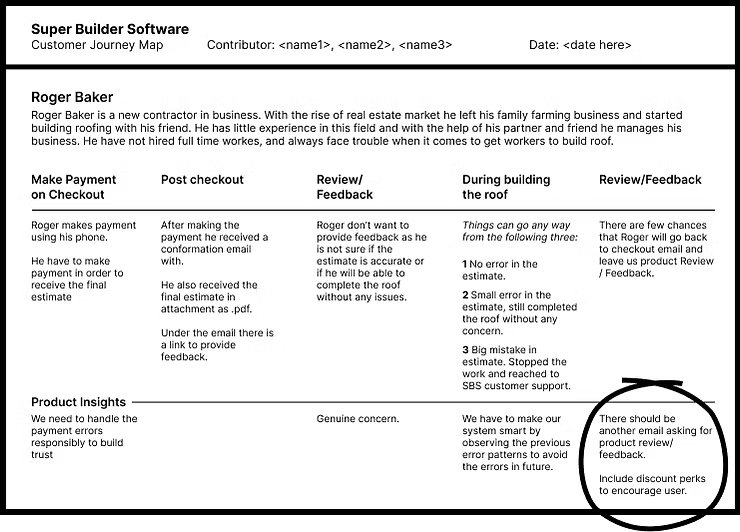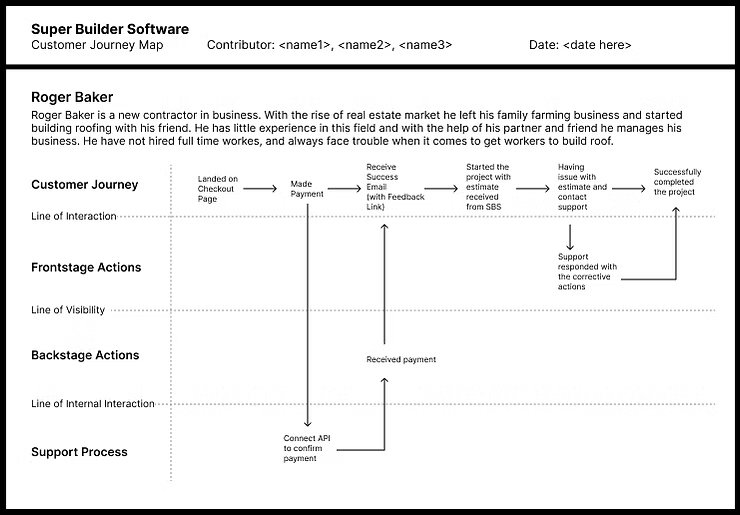Power of Journey Maps in UX
Journey mapping is a cornerstone of modern UX strategy, ranking among the most popular methods used by professionals to visualize and improve user experiences. Far more than just a flowchart, a well-executed journey map is a powerful tool for building empathy, breaking down organizational silos, and aligning teams around a shared, user-centered vision. While its core goal is to tell a story from the user's perspective, the term "journey map" can refer to several different artifacts. This article breaks down the three primary types of maps—Experience Maps, Customer Journey Maps, and Service Blueprints—using a single, practical scenario to illustrate their distinct strategic roles.

The Scenario: Super Builder Software
To explore these maps, let's imagine a hypothetical company: 'Super Builder Software' (SBS). SBS provides a digital platform that helps roofing contractors estimate project costs by selecting materials, calculating roof sizes, and forecasting labor needs. The software is successful at streamlining the quoting process, which is a major pain point for its users.
The Business Problem
Despite a healthy number of orders, the company receives very few customer reviews. This lack of feedback means SBS has no insight into post-service satisfaction, misses out on valuable testimonials for marketing, and lacks the qualitative data needed to iterate and improve its product.
What is a Journey Map?
At its core, a journey map is a visualization of the experience a person has while trying to achieve a goal. It's a narrative artifact that captures the nuances of a user's reality. While formats vary, most journey maps provide a structured view of the user's world by including:
- Phases: The major stages of the journey (e.g., Awareness, Consideration, Purchase, Service, Loyalty). These provide the high-level structure.
- Actions: The specific tasks and behaviors the user is performing at each phase. This is the "what."
- Mindsets & Emotions: What the user is thinking and feeling. This is the emotional layer of the journey, crucial for identifying moments of frustration, confusion, or delight.
- Touchpoints: Where the user interacts with the company or product (e.g., website, app, email, customer support).
- Opportunities: Actionable insights gained from the map that highlight where the experience can be improved, optimized, or innovated.
The 3 Types of Maps
1. Experience Map: The 10,000-Foot View
An Experience Map is the broadest type of journey map, created to understand human behavior at a macro level, independent of any specific product. The process often involves foundational research like ethnographic studies and in-depth user interviews. Its power lies in being product-agnostic, allowing teams to discover entirely new opportunities for innovation.

For SBS: An experience map would visualize the entire world of a contractor trying to run their business. It would start from the moment they get a lead, to visiting the site, doing manual calculations, dealing with suppliers, managing their crew, and finally invoicing the client. By deliberately ignoring the SBS software, the team might discover significant pain points they never knew existed—perhaps in material procurement or crew scheduling. These unmet needs could become the basis for the next generation of features for the SBS platform.
2. Customer Journey Map: Zooming in on Your Product
A Customer Journey Map focuses on the experience of a specific customer persona as they interact directly with your product or service to achieve a goal. It is the ideal tool for diagnosing and improving the existing user experience.

For SBS: This is the perfect tool to diagnose the review problem. The team would map the journey of "Carlos, the Busy Contractor" using the SBS platform. The map would show his initial satisfaction when the software quickly generates an accurate estimate. It would follow him as he successfully places his material order. But then, the journey would hit a wall. In the "Post-Job" phase, the map would reveal his emotions shifting to indifference or being forgotten, as there are no touchpoints to re-engage him. The opportunity becomes crystal clear: initiate contact after the job is done to guide the user toward leaving feedback.
- McKinsey"Maximizing satisfaction with customer journeys has the potential not only to increase customer satisfaction by 20% but also lift revenue up by 15% while lowering the cost of serving customers by as much as 20%."
3. Service Blueprint: Connecting the Frontstage and Backstage
A Service Blueprint is a strategic diagram that connects the customer-facing journey to the internal operations that make it possible. It visualizes the entire ecosystem of your service, including people, processes, and technology, across distinct "swimlanes." It's essential for planning the implementation of a new feature.

For SBS: To implement the "ask for a review" feature, a service blueprint would be created. It would detail:
- Customer Actions (Onstage): The contractor receives an email and clicks a link to leave a review.
- Frontstage Actions (Onstage): What the contractor sees. The automated email is sent from the company's server. The review form is displayed on the website.
- Backstage Actions: The internal processes. An automation rule in the CRM is triggered. The customer support team is notified of a new review. The review is processed and stored in a database.
- Support Processes: The underlying systems. The CRM software, the email server, the website hosting, and the database that all need to function correctly.
- By mapping all these dependencies, SBS can ensure that when they launch this new feature, the internal operations are fully prepared to support it.
Conclusion
Choosing the RTight Map for the Jop
While all three artifacts visualize an experience, they offer different strategic lenses. An Experience Map is for discovery, helping you find new problems to solve. A Customer Journey Map is for optimization, helping you fix existing problems in your product. A Service Blueprint is for implementation, helping you plan the operational execution of your solution. Understanding and utilizing these tools allows teams to foster a deeply user-centric culture, building experiences that are not only seamless for users but also efficient and sustainable for the business.
References & Links
- Nielsen Norman Group (NNG) - This source is for the statistic on the popularity of journey mapping as a UX method. NNG is a leading authority in the UX field. Journey Mapping 101
- Interaction Design Foundation (IxDF) - This is the source you mentioned for the foundational concepts and definitions of the three map types. Their course and literature provide a deep dive into the subject. Journey Mapping
- McKinsey & Company - This is the source for the powerful statistic on the business impact of improving the customer journey. The Three Cs of Customer Satisfaction